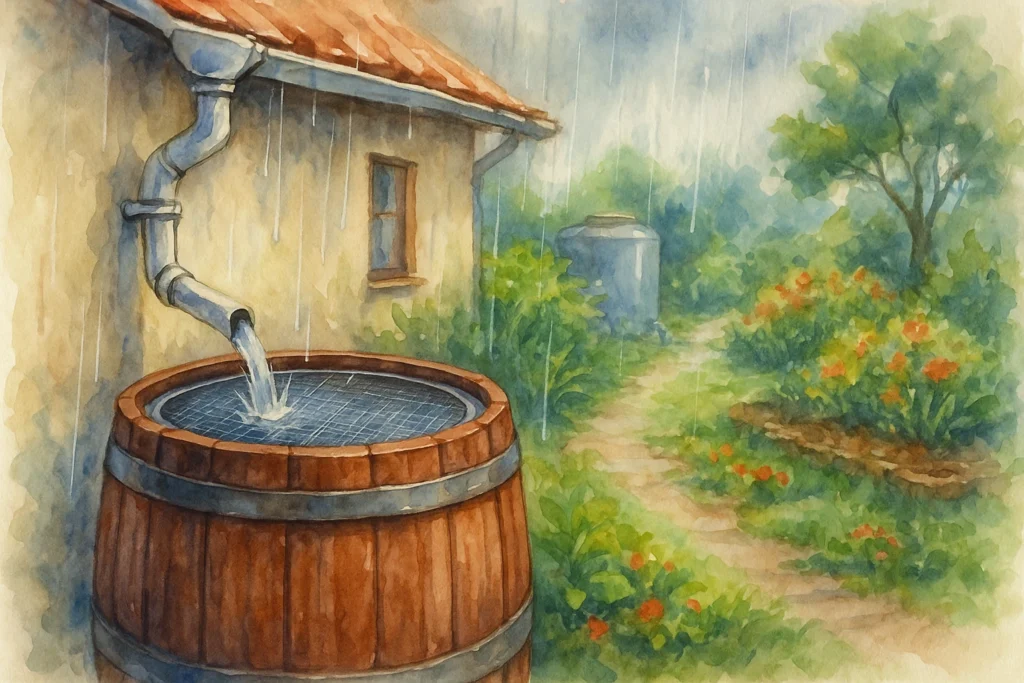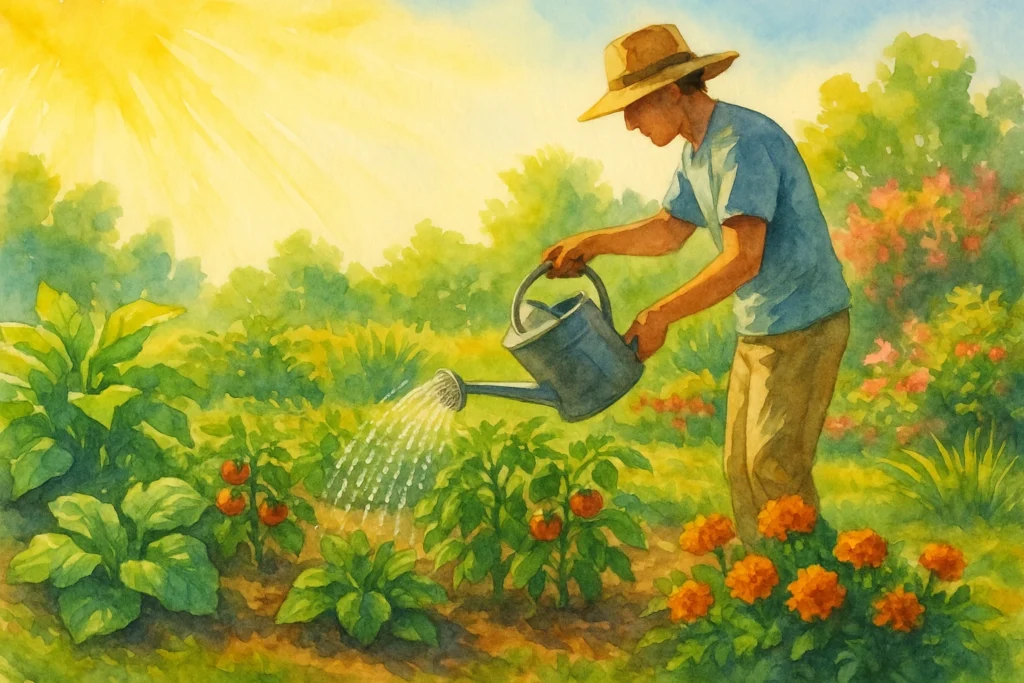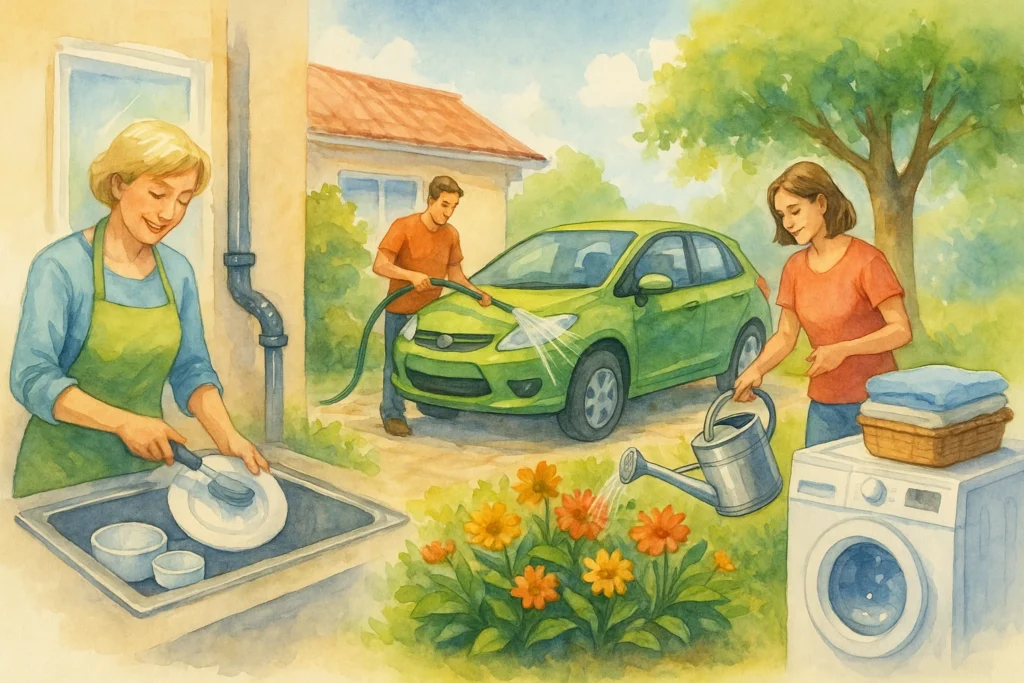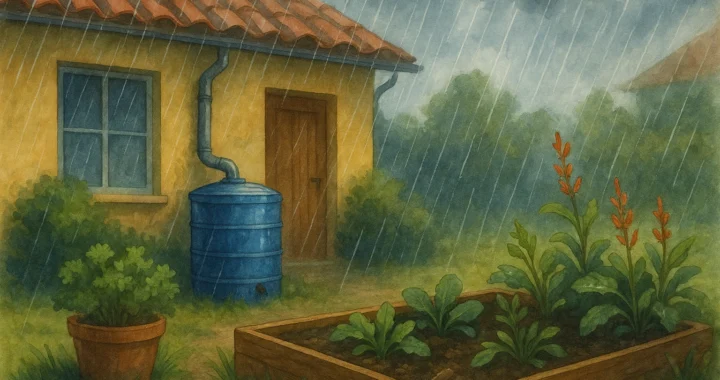Water insecurity already affects over 2.2 billion people globally, and the issue is growing. Much of the rain that falls still runs off rooftops and into drains, wasted before it ever reaches our gardens or tanks.
The good news is that you don’t need a high-tech solution to make a difference. All it takes is a barrel, a bit of planning, and a willingness to use what nature gives freely.
Rainwater harvesting is one of the most accessible sustainable water solutions for homes and gardens. But what exactly does it involve? This guide will show you how to collect rain, store it safely, and use it in simple, effective ways.
Let’s start by looking at how the system works and what you’ll need to get started.
What Is Rainwater Harvesting? A Modern Twist on an Ancient Practice
Rainwater harvesting is the practice of collecting rain from rooftops and storing it for later use. This idea is not new. Ancient civilisations used clay jars, stone cisterns, and carved channels to save rain during dry seasons. Today, the concept remains the same, but the materials and methods have evolved significantly.
Instead of letting rainwater disappear down the drain, you can collect and store it for practical use around the home. This free resource can reduce your reliance on the mains supply and support a more sustainable lifestyle.
How It Works
The typical system begins at your roof. Rain flows into gutters, then down into a collection point, usually a storage tank or barrel.

To keep the water clean, most systems include:
- Gutter guards or leaf screens to block large debris
- First-flush diverters to discard the initial dirty runoff from the roof
- Filters or mesh screens to trap fine particles
- Tightly sealed tanks or barrels to prevent mosquito breeding and algae growth
The collected water can then be accessed through taps, pumps, or connected directly to irrigation systems. Some homeowners even treat their stored rainwater for indoor use.
Types of Rainwater Harvesting Systems
There is a solution for nearly every home, budget, and level of experience:
- DIY Barrel Systems: A low-cost entry point that uses basic barrels and downspout diverters to capture and store water. These are ideal for garden use.
- Above-Ground Tank Systems: Slightly more complex setups that include larger capacity tanks. These may be linked together and paired with pumps for easier access.
- Underground Storage Systems: High-capacity options that hide tanks below ground. These systems often include automatic pumping and filtration for full home integration.
All systems are scalable. Many people start with one or two barrels and then add tanks, filters, or solar-powered pumps over time.
With that foundation in mind, it’s time to explore why this simple system makes such a big difference for your home and the planet.
Why Every Drop Counts: Benefits You’ll Notice Fast
So, what can you expect once your system is up and running? Aside from the positive environmental impact, rainwater collection offers clear, practical benefits for daily use. The benefits are immediate and easy to see.

Let’s have a look at these benefits:
Save on Your Water Bills
Using rainwater in place of mains water can lower your utility costs almost immediately. On average, it can reduce your water bills by up to 50 percent. Even a modest system collecting runoff from a small roof can save thousands of litres annually. This is especially helpful in areas where water is metered or where usage tiers lead to sharp bill increases.
Based on our firsthand experience, we found that a 100-gallon barrel filled from a single downpipe consistently offsets outdoor water use for up to two weeks. Over the course of one summer, this reduced outdoor water bills by over 30 percent.
But the benefits don’t stop there. You can use rainwater to wash your car, rinse outdoor gear, clean patios, and top up ornamental ponds. Households with larger systems often see savings in laundry, toilet flushing, or topping up pools. Over time, these savings make up for the cost of the system, often within two to three years.
Water When Your Garden Needs It
Nothing is more frustrating for gardeners than trying to keep plants healthy under watering restrictions. When your rain tank is full, you don’t have to worry about time-of-day rules or sprinkler bans. You can water when your garden actually needs it.
This flexibility helps you avoid heat stress on plants, especially during summer or dry periods. Drip irrigation or gravity-fed systems can be attached to tanks, making watering efficient and precise, even while you’re away.
Give Your Plants a Better Drink
Tap water often contains chlorine, fluoride, and minerals that accumulate in soil over time. While safe for people, these additives can stress sensitive plants and degrade soil quality. Rainwater, by contrast, is naturally soft and slightly acidic, which most garden plants prefer.
Using untreated rainwater promotes healthier root systems, encourages microbial life in soil, and reduces the risk of leaf burn. Over time, this can improve yield in vegetable gardens and extend the life of ornamental plants.
Our in-house subject experts concluded that vegetable plots watered with untreated rainwater grew faster and showed richer foliage than those using tap water. Tomatoes, herbs, and seedlings all showed visible improvement in health and vigour.
Reduce Your Environmental Footprint
Every litre of rain you harvest is one less drawn from reservoirs, aquifers, or treatment plants. That means less energy used to pump, purify, and deliver water to your home. You are not just conserving water, you are easing the demand on infrastructure and reducing emissions associated with water treatment.
Harvesting rain also cuts down on runoff, which can carry pesticides, oils, and pollutants into storm drains and natural waterways. Capturing it on-site helps keep local creeks and rivers cleaner and supports healthier ecosystems.
Add Resilience to Your Home
With climate patterns becoming less predictable, water security is a growing concern. A well-placed rainwater system can act as a buffer during dry weeks, supply water during outages, or keep your garden alive during a heatwave.
In areas prone to drought or supply interruptions, a rainwater tank adds value to your home not just in resale, but in day-to-day confidence.
A Small Habit With Big Results
Rainwater harvesting is proof that small actions can add up. A single tank, topped up by just one downpipe, can supply thousands of litres over a year. Once you have seen your first full barrel after a rainy night, you will realise how much water you have been letting go to waste.
The best part is that even a single tank can make a difference. When you are ready to scale up, adding capacity is easy. So how do you choose the right system and set it up correctly?
Let’s walk through what you need to get started.
Getting Started: Choosing the Right Rainwater System for Your Home
Setting up a rainwater harvesting system is easier than it might seem, and it all starts with choosing what works best for your situation. That includes your space, your climate, and what you want to achieve.
Start by Watching Your Roof
The best system starts with observation. Watch how rain flows off your roof. Where are the downpipes located? How much runoff is being wasted? This will help you decide where to place your tank or barrel.
Roofs with cleaner surfaces, like tiles or metal, are ideal for collecting water. The larger the roof area, the more rain you can capture. Even small sheds or patio covers can be used with mini-barrels or wall-mounted tanks.
Pick a System That Matches Your Goals
If your main goal is garden watering, a simple above-ground barrel with a screen and tap is often enough. These are easy to install and maintain, and they do not require pumps or filters.
For those wanting more functionality, such as indoor use or high-volume storage, consider a larger tank setup. Options include:
- Above-ground poly tanks for easy access and installation
- Underground tanks for saving space in smaller yards
- Modular slimline tanks that fit along fences or walls
If you plan to use the water indoors, look into first-flush diverters, finer filters, and UV or carbon treatment systems to ensure the water is safe.
Think About Placement and Safety
Your tank should sit on a level, stable base. Water is heavy, and a full tank can weigh several hundred kilograms. Use a concrete slab, a compacted gravel pad, or a prefabricated tank stand. Make sure overflow pipes are directed away from your home’s foundation.
Through our hands-on experience, we learned that setting a tank directly on soil, even temporarily, leads to uneven settling over time and stress on fittings. A compacted gravel pad or a purpose-built stand made emptying, maintenance, and expansion much easier down the track.
Just as the base matters, so does what goes on top. Always cover tanks with tight-fitting lids or mesh to keep mosquitoes and debris out. Choose opaque or dark-coloured containers to prevent algae growth, especially in sunny areas.
Check for Local Rules and Rebates
Before buying anything, check your local council regulations. Some regions require permits for larger tanks or systems connected to household plumbing. You may also qualify for rebates or water-saving incentives, which can reduce your upfront costs.
Community groups, gardening centres, and even local governments often offer workshops or resources to help first-timers. These are great places to ask questions and compare products.
Once your system is collecting water, the next step is making the most of it. From outdoor chores to indoor essentials, there are plenty of smart ways to use rainwater in your daily routine, and we’re about to show you how.
Smart Ways to Use Your Rainwater Every Day
The value of rainwater collection grows when you start using it regularly. There are many everyday tasks where rainwater can easily take the place of tap water and help you save more in the long run.

Here are some smart ideas to help you get started:
Outdoor Uses
For most people, the garden is where rainwater harvesting delivers instant value. Plants love rainwater. It is free from chlorine, naturally soft, and better for soil health. Use it for:
- Watering vegetable patches, flower beds, and lawns
- Topping up birdbaths, ponds, or small fountains
- Washing garden tools, bikes, or the car
- Cleaning windows, patios, and outdoor furniture
Even in small volumes, rainwater is ideal for spot-watering delicate plants or seedlings that do not tolerate tap water well.
Indoor Uses
If your system includes filtration and plumbing connections, rainwater can be used inside your home as well. Popular indoor uses include:
- Flushing toilets
- Washing clothes (with treated rainwater)
- Running evaporative cooling systems
- Emergency supply during outages or restrictions
For indoor use, always make sure your water is filtered and treated according to local health guidelines. Not all regions allow untreated rainwater for household use, so it is important to check what is permitted in your area.
Pairing with Greywater
Rainwater is just one part of a sustainable water plan. Many homeowners combine rain collection with greywater reuse systems, which redirect used water from laundry or sinks for use in the garden. Together, these two systems can dramatically cut your reliance on mains water.
Maximise Every Drop
Use rainwater early and often, especially in the days following a storm. Keeping your tank partly empty ensures there is room to collect again when the next rain arrives.
We tested different watering schedules and found that using rainwater two days after a rainfall gave the best uptake for root systems, as the soil had partially dried and absorbed moisture more efficiently.
Consider adding:
- Drip irrigation systems for efficient watering
- Float valves to control overflow
- Simple water level gauges to track how much you have
Even if your storage is small, consistent use makes a big difference. Over a year, a single barrel can supply thousands of litres of free, fresh water.
Now that you know how to make your harvested rainwater work for you, we will look at how to get started with confidence. The next section shares simple, step-by-step advice for beginners who want to build a system that grows with their needs.
Start Small and Grow: Tips for First-Time Harvesters
Starting with a basic rainwater system can feel daunting, especially if you’ve never worked with plumbing or tanks before. But the most effective systems are the ones that grow with you.
These beginner-focused tips will help you avoid common frustrations and get results quickly, even with a modest setup.
Start During a Rainy Season
If possible, set up your system just before or during your local wet season. This ensures your tank or barrel fills quickly, which helps you see results right away. Early success makes it more likely you’ll stick with the habit and expand later.
Choose a Simple Task for Your First Use
Instead of planning for full garden irrigation right away, start by using rainwater for a small job like watering potted herbs or rinsing tools. This builds routine and gives you a sense of satisfaction without pressure.
Install a Visible Water Gauge
A simple water level indicator, like a float gauge or sight tube, helps you monitor how much water you’ve stored. It’s a great way to learn how quickly your barrel fills after a storm and how much you’re using between rains. It also reminds you to use water regularly so your system stays functional.
We’ve seen cases like a customer in Brisbane who assumed their barrel wasn’t filling enough to matter. Once they installed a simple gauge and started tracking their use, they were surprised to learn they were saving more than 500 litres each month from just one downpipe. That small bit of awareness turned into long-term commitment.
Track Your Results to Stay Motivated
Speaking of tracking results, keep a simple log of how much rainwater your system collects and how often you use it. It will help you understand your usage patterns, estimate savings, and decide if you need more storage. You can use a notebook, phone app, or even a spreadsheet.
Connect With Local Gardening or Sustainability Groups
Many communities have local gardening clubs or eco groups that offer workshops, share tips, and even sell barrels or accessories at discounted rates. These groups often provide region-specific advice based on local rainfall patterns and garden conditions.
Label Rainwater Taps and Valves
If you have multiple taps or hoses around your home, clearly label the ones connected to rainwater. This avoids confusion and ensures you know which source you’re using, especially important if you later add more tanks or install a pump.
Join a Local or Online Community
You’re not alone in figuring this out. Joining a local garden club, Facebook group, or sustainability forum lets you share wins, ask questions, and avoid beginner mistakes. It makes the process feel collaborative and much more fun.
Don’t Wait for the Perfect Setup
It’s easy to overthink the design or aim for the “ideal” system. But getting started is more important than getting everything perfect. A single barrel is enough to begin learning, and you can always upgrade and expand as your needs change.
Inspect After Each Rainfall
After it rains, take a few minutes to check your barrel or tank. Look for signs of overflow, blockages in the gutter or downpipe, and any unusual smells or leaks. Early maintenance prevents issues and helps you understand how your system behaves in different weather.
Start where you are, use what you have, and grow from there. The journey toward more sustainable water use begins with just one rainy day and the decision to save it.
In the next section, we will look at how to scale up your rainwater harvesting system to meet bigger goals, from full garden irrigation to home integration.
From Barrel to System: Scaling Up Your Rainwater Harvesting
Once you’ve seen how much rain a single barrel can collect, it’s only natural to wonder: what if you could store even more? As your confidence grows, so can your system. Expanding your rainwater harvesting setup means increasing your storage, improving access, and finding smarter ways to use the water you collect.

Connect Multiple Barrels or Tanks
The easiest way to scale up is by connecting additional barrels to your existing downpipe. Linking tanks together with simple connectors allows overflow from one tank to feed directly into another. This can double or triple your storage without adding much complexity.
If you have multiple downpipes on your house, you can install a collection point at each location. This helps maximise water collection across your entire roof.
Add a Pump for Flexibility
A gravity-fed system works well for watering by hand, but as your system grows, a small pump can make life much easier. Pumps allow you to use standard garden hoses, sprinkler systems, or even automate watering with timers. Battery, electric, and solar-powered options are all available.
Install Smart Irrigation Features
If you’re serious about gardening, connecting your tank to a drip irrigation system can deliver water directly to your plants’ roots. Drip systems reduce waste, prevent overwatering, and make garden care more efficient, especially in hot or dry climates.
Add a timer and you can set it and forget it, letting your system water your plants while you’re away or busy with other tasks.
Explore Indoor Use and Full Home Integration
With proper treatment and plumbing connections, rainwater can be used indoors for flushing toilets, doing laundry, and more. These systems require additional components like filters, backflow prevention, and possibly UV treatment, but they significantly expand the utility of your rainwater.
Each new piece you add brings you closer to a home that uses water wisely and responsibly. And as you scale up, it’s worth stepping back to remember why this all matters in the first place. Let’s take a moment to reflect on the bigger picture.
Let the Rain Work for You
Rainwater harvesting is a reminder that the simplest solutions are often the most powerful. With one tank, one barrel, or one careful plan, you can turn weather into a resource and your home into part of something bigger.
You become less reliant on strained infrastructure, less vulnerable to dry seasons, and more in tune with how your household uses water. The change may seem small at first, but over time, it builds into something meaningful.
You are also contributing to a healthier planet. Less runoff means cleaner waterways. Less demand on mains supply eases pressure on dams and treatment plants. And by reusing what nature gives, you are helping create a more balanced and resilient future.
Perfection isn’t the goal. What matters is taking small, practical steps with the resources you have. It can start with just one rainy day and a choice to save the water instead of letting it go to waste.

